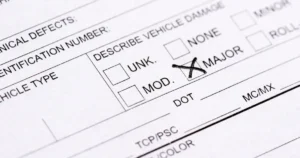 Every day, more than eight people die and 1,161 suffer injuries in accidents caused by a distracted driver, according to the U.S. Centers for Disease Control and Prevention.
Every day, more than eight people die and 1,161 suffer injuries in accidents caused by a distracted driver, according to the U.S. Centers for Disease Control and Prevention.
Distracted driving causes thousands of car accident deaths per year and hundreds of thousands of injuries. Unfortunately, recent trends suggest that the number of deaths and injuries will only increase. If you have been injured in a car accident contact one of the experienced South Bend car accident attorneys at Pfeifer Morgan & Stesiak for a free consultation.
That is why April has been designated as Distracted Driving Awareness Month. This is a chance for federal, state and local authorities to educate the public about the prevalence of distracted driving and the reasons why it is so dangerous.
State and local law enforcement in Indiana will also use this month as an opportunity to step up enforcement efforts so they can catch distracted drivers in the act.
Defining Distracted Driving
Distracted driving is defined as engaging in any activity that takes your focus off the primary task of driving. There are three different types of activities or distractions:
- Cognitive distractions that occupy the mind of the driver
- Manual distractions that require drivers to take their hands off the steering wheel
- Visual distractions that cause drivers to take their eyes off the road
However, most distractions are a combination of visual, cognitive and manual distractions.
Some of the most common forms of distracted driving include:
- Texting and driving
- Making or receiving phone calls
- Heated conversations or arguments with passengers
- Eating or drinking
- Grooming, including applying makeup, shaving or combing your hair
- Playing with the radio or other settings, including cruise control and air conditioning
- Using a GPS or navigation system
- Reaching for objects in other parts of the car
- Smoking cigarettes
- Playing with a pet that is not secured in a kennel or portable cage
- Watching videos on a cellphone
- Reading or posting things to social media
Indiana Laws on Cellphone Use While Driving
Indiana is one of many states to institute a complete ban on texting and driving. The law, which took effect on July 1, 2011, outlaws the use of a cellphone for:
- Typing a text message or email
- Sending a text message or email
- Reading an email or text message
However, the law makes two major exceptions. It states that cellphones may be used for the purpose of:
- Sending text messages or emails via a hands-free or voice-operated setting on the device
- Calling 911 to report an actual emergency
State law also prohibits drivers who are younger than 18 years old from using a cellphone while driving, including using the hands-free or voice-operated function.
This is a primary law so it allows police officers to pull over offenders even if they have not committed another traffic offense. Offenders face potential fines of up to $500.
Distracted Driving Statistics
There are many things that cause more Indiana traffic accidents than distracted driving. However, distracted driving is a significant problem on Indiana roadways.
In 2014, distracted driving led to 5,527 accidents, with 22.4 fatal or incapacitating injuries per 1,000 collisions, according to Indiana Crash Facts 2014.
Across the nation, distracted driving caused 3,179 deaths in 2014. Unfortunately, that number increased to 3,477 in 2015. Distracted driving also caused approximately 391,000 injuries in 2015.
A survey from the AAA Foundation shows that distracted driving is a problem across all age groups. A majority of drivers from all age groups admitted to texting and driving at least once in the past month.
Distracted driving is not limited to roadways either, as a survey from the National Safety Council revealed that large percentages of drivers engage in distracted driving in parking lots. Researchers found that 66 percent of respondents make phone calls, 56 percent send texts and 52 percent post on social media.
How do I Avoid Distracted Driving?
The key to preventing distracted driving is to plan ahead to reduce the temptation to engage in any distracted driving behaviors. For instance, before you leave, you need to take care of certain things, like:
- Eating or drinking
- Grooming
- Making phone calls
- Sending texts or emails
- Setting your GPS or mobile navigation system
You should always try to avoid using your cellphone unless you are in a true emergency. Even then, you should have a passenger use your phone to make a call or send a text or email. If you are driving alone, pull over to the shoulder or another safe location before making a phone call or sending a text or email.
You should always aim to travel with fewer passengers because traveling with a lot of passengers increases the likelihood of distractions.
Injured in an accident caused by a distracted driver?
You may be entitled to compensation for physical, financial and emotional damages. Contact a South Bend personal injury lawyer at Pfeifer, Morgan and Stesiak for a free, no obligation legal consultation.
We do not charge for our services unless there is a favorable resolution of your claim.
Call us today at (574) 444-0741.




